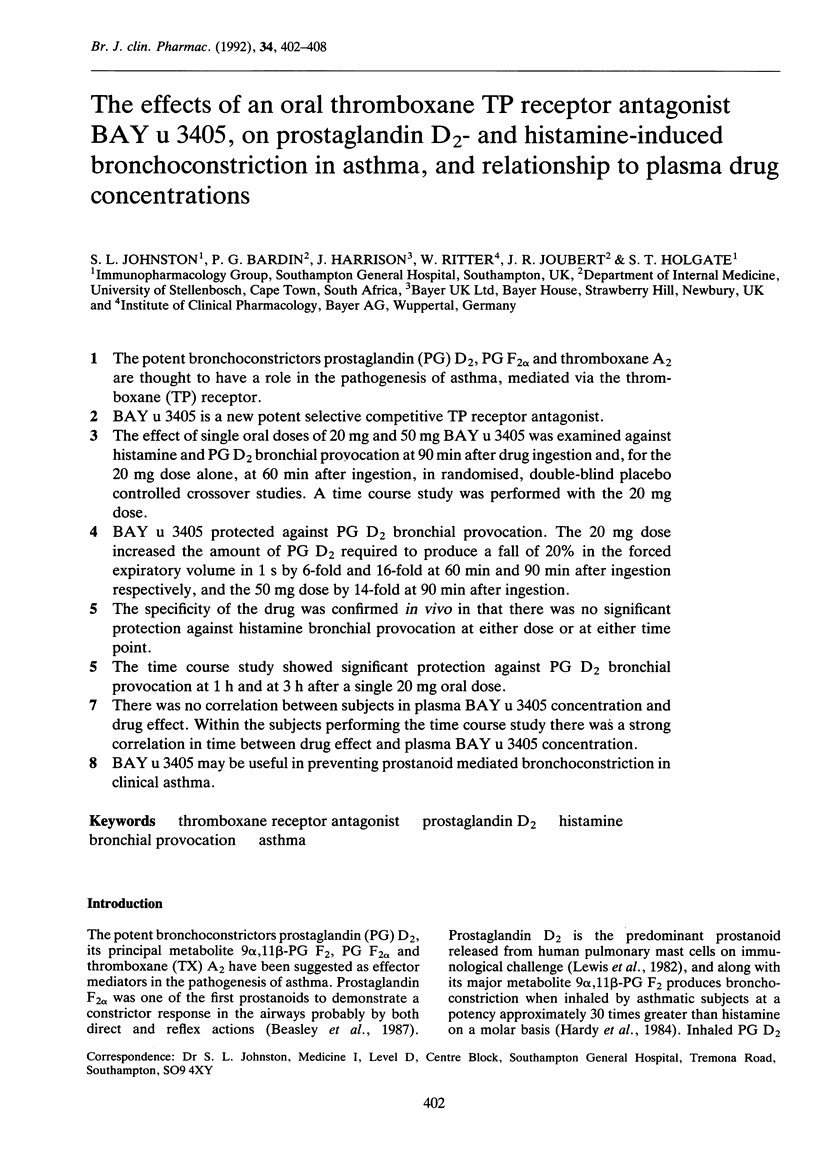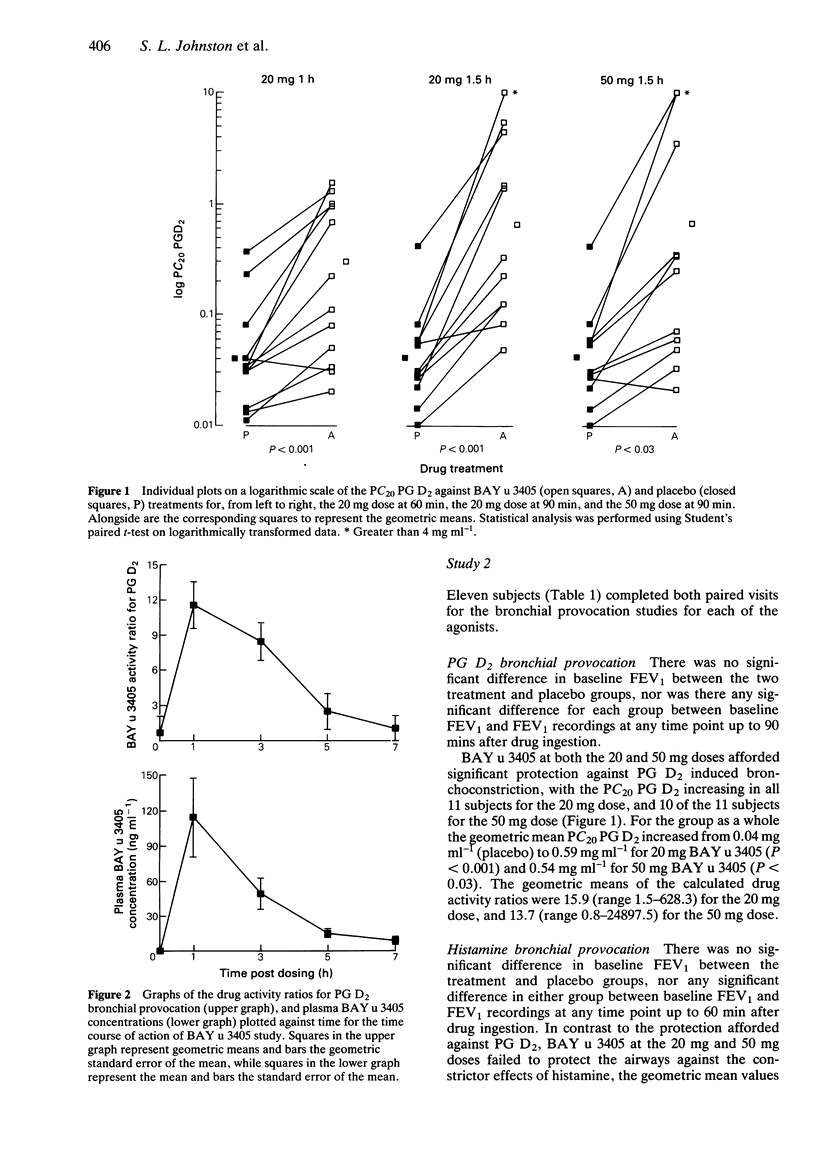Abstract
1. The potent bronchoconstrictors prostaglandin (PG) D2, PG F2 alpha and thromboxane A2 are thought to have a role in the pathogenesis of asthma, mediated via the thromboxane (TP) receptor. 2. BAY u 3405 is a new potent selective competitive TP receptor antagonist. 3. The effect of single oral doses of 20 mg and 50 mg BAY u 3405 was examined against histamine and PG D2 bronchial provocation at 90 min after drug ingestion and, for the 20 mg dose alone, at 60 min after ingestion, in randomised, double-blind placebo controlled crossover studies. A time course study was performed with the 20 mg dose. 4. BAY u 3405 protected against PG D2 bronchial provocation. The 20 mg dose increased the amount of PG D2 required to produce a fall of 20% in the forced expiratory volume in 1 s by 6-fold and 16-fold at 60 min and 90 min after ingestion respectively, and the 50 mg dose by 14-fold at 90 min after ingestion. 5. The specificity of the drug was confirmed in vivo in that there was no significant protection against histamine bronchial provocation at either dose or at either time point. 6. The time course study showed significant protection against PG D2 bronchial provocation at 1 h and at 3 h after a single 20 mg oral dose. 7. There was no correlation between subjects in plasma BAY u 3405 concentration and drug effect. Within the subjects performing the time course study there was a strong correlation in time between drug effect and plasma BAY u 3405 concentration.(ABSTRACT TRUNCATED AT 250 WORDS)
Full text
PDF






Selected References
These references are in PubMed. This may not be the complete list of references from this article.
- Beasley R. C., Featherstone R. L., Church M. K., Rafferty P., Varley J. G., Harris A., Robinson C., Holgate S. T. Effect of a thromboxane receptor antagonist on PGD2- and allergen-induced bronchoconstriction. J Appl Physiol (1985) 1989 Apr;66(4):1685–1693. doi: 10.1152/jappl.1989.66.4.1685. [DOI] [PubMed] [Google Scholar]
- Beasley R., Varley J., Robinson C., Holgate S. T. Cholinergic-mediated bronchoconstriction induced by prostaglandin D2, its initial metabolite 9 alpha,11 beta-PGF2, and PGF2 alpha in asthma. Am Rev Respir Dis. 1987 Nov;136(5):1140–1144. doi: 10.1164/ajrccm/136.5.1140. [DOI] [PubMed] [Google Scholar]
- Bland J. M., Altman D. G. Statistical methods for assessing agreement between two methods of clinical measurement. Lancet. 1986 Feb 8;1(8476):307–310. [PubMed] [Google Scholar]
- Chai H., Farr R. S., Froehlich L. A., Mathison D. A., McLean J. A., Rosenthal R. R., Sheffer A. L., Spector S. L., Townley R. G. Standardization of bronchial inhalation challenge procedures. J Allergy Clin Immunol. 1975 Oct;56(4):323–327. doi: 10.1016/0091-6749(75)90107-4. [DOI] [PubMed] [Google Scholar]
- Coleman R. A., Sheldrick R. L. Prostanoid-induced contraction of human bronchial smooth muscle is mediated by TP-receptors. Br J Pharmacol. 1989 Mar;96(3):688–692. doi: 10.1111/j.1476-5381.1989.tb11869.x. [DOI] [PMC free article] [PubMed] [Google Scholar]
- Emery D. L., Djokic T. D., Graf P. D., Nadel J. A. Prostaglandin D2 causes accumulation of eosinophils in the lumen of the dog trachea. J Appl Physiol (1985) 1989 Sep;67(3):959–962. doi: 10.1152/jappl.1989.67.3.959. [DOI] [PubMed] [Google Scholar]
- Fairfax A. J., Hanson J. M., Morley J. The late reaction following bronchial provocation with house dust mite allergen. Dependence on arachidonic acid metabolism. Clin Exp Immunol. 1983 May;52(2):393–398. [PMC free article] [PubMed] [Google Scholar]
- Finnerty J. P., Holgate S. T. Evidence for the roles of histamine and prostaglandins as mediators in exercise-induced asthma: the inhibitory effect of terfenadine and flurbiprofen alone and in combination. Eur Respir J. 1990 May;3(5):540–547. [PubMed] [Google Scholar]
- Finnerty J. P., Wilmot C., Holgate S. T. Inhibition of hypertonic saline-induced bronchoconstriction by terfenadine and flurbiprofen. Evidence for the predominant role of histamine. Am Rev Respir Dis. 1989 Sep;140(3):593–597. doi: 10.1164/ajrccm/140.3.593. [DOI] [PubMed] [Google Scholar]
- Francis H. P., Greenham S. J., Patel U. P., Thompson A. M., Gardiner P. J. BAY u3405 an antagonist of thromboxane A2- and prostaglandin D2-induced bronchoconstriction in the guinea-pig. Br J Pharmacol. 1991 Nov;104(3):596–602. doi: 10.1111/j.1476-5381.1991.tb12475.x. [DOI] [PMC free article] [PubMed] [Google Scholar]
- Fujimura M., Sakamoto S., Saito M., Miyake Y., Matsuda T. Effect of a thromboxane A2 receptor antagonist (AA-2414) on bronchial hyperresponsiveness to methacholine in subjects with asthma. J Allergy Clin Immunol. 1991 Jan;87(1 Pt 1):23–27. doi: 10.1016/0091-6749(91)90208-6. [DOI] [PubMed] [Google Scholar]
- Fuller R. W., Dixon C. M., Dollery C. T., Barnes P. J. Prostaglandin D2 potentiates airway responsiveness to histamine and methacholine. Am Rev Respir Dis. 1986 Feb;133(2):252–254. doi: 10.1164/arrd.1986.133.2.252. [DOI] [PubMed] [Google Scholar]
- Hardy C. C., Bradding P., Robinson C., Holgate S. T. The combined effects of two pairs of mediators, adenosine with methacholine and prostaglandin D2 with histamine, on airway calibre in asthma. Clin Sci (Lond) 1986 Oct;71(4):385–392. doi: 10.1042/cs0710385. [DOI] [PubMed] [Google Scholar]
- Hardy C. C., Robinson C., Tattersfield A. E., Holgate S. T. The bronchoconstrictor effect of inhaled prostaglandin D2 in normal and asthmatic men. N Engl J Med. 1984 Jul 26;311(4):209–213. doi: 10.1056/NEJM198407263110401. [DOI] [PubMed] [Google Scholar]
- Hills M., Armitage P. The two-period cross-over clinical trial. Br J Clin Pharmacol. 1979 Jul;8(1):7–20. doi: 10.1111/j.1365-2125.1979.tb05903.x. [DOI] [PMC free article] [PubMed] [Google Scholar]
- Lewis R. A., Soter N. A., Diamond P. T., Austen K. F., Oates J. A., Roberts L. J., 2nd Prostaglandin D2 generation after activation of rat and human mast cells with anti-IgE. J Immunol. 1982 Oct;129(4):1627–1631. [PubMed] [Google Scholar]
- Liu M. C., Bleecker E. R., Lichtenstein L. M., Kagey-Sobotka A., Niv Y., McLemore T. L., Permutt S., Proud D., Hubbard W. C. Evidence for elevated levels of histamine, prostaglandin D2, and other bronchoconstricting prostaglandins in the airways of subjects with mild asthma. Am Rev Respir Dis. 1990 Jul;142(1):126–132. doi: 10.1164/ajrccm/142.1.126. [DOI] [PubMed] [Google Scholar]
- McKenniff M. G., Norman P., Cuthbert N. J., Gardiner P. J. BAY u3405, a potent and selective thromboxane A2 receptor antagonist on airway smooth muscle in vitro. Br J Pharmacol. 1991 Nov;104(3):585–590. doi: 10.1111/j.1476-5381.1991.tb12473.x. [DOI] [PMC free article] [PubMed] [Google Scholar]
- McKenniff M., Rodger I. W., Norman P., Gardiner P. J. Characterisation of receptors mediating the contractile effects of prostanoids in guinea-pig and human airways. Eur J Pharmacol. 1988 Aug 24;153(2-3):149–159. doi: 10.1016/0014-2999(88)90601-2. [DOI] [PubMed] [Google Scholar]
- Murray J. J., Tonnel A. B., Brash A. R., Roberts L. J., 2nd, Gosset P., Workman R., Capron A., Oates J. A. Release of prostaglandin D2 into human airways during acute antigen challenge. N Engl J Med. 1986 Sep 25;315(13):800–804. doi: 10.1056/NEJM198609253151304. [DOI] [PubMed] [Google Scholar]
- Norel X., Labat C., Gardiner P. J., Brink C. Inhibitory effects of BAY u3405 on prostanoid-induced contractions in human isolated bronchial and pulmonary arterial muscle preparations. Br J Pharmacol. 1991 Nov;104(3):591–595. doi: 10.1111/j.1476-5381.1991.tb12474.x. [DOI] [PMC free article] [PubMed] [Google Scholar]
- Rafferty P., Holgate S. T. Terfenadine (Seldane) is a potent and selective histamine H1 receptor antagonist in asthmatic airways. Am Rev Respir Dis. 1987 Jan;135(1):181–184. doi: 10.1164/arrd.1987.135.1.181. [DOI] [PubMed] [Google Scholar]
- Shephard E. G., Malan L., Macfarlane C. M., Mouton W., Joubert J. R. Lung function and plasma levels of thromboxane B2, 6-ketoprostaglandin F1 alpha and beta-thromboglobulin in antigen-induced asthma before and after indomethacin pretreatment. Br J Clin Pharmacol. 1985 Apr;19(4):459–470. doi: 10.1111/j.1365-2125.1985.tb02671.x. [DOI] [PMC free article] [PubMed] [Google Scholar]
- Wenzel S. E., Westcott J. Y., Smith H. R., Larsen G. L. Spectrum of prostanoid release after bronchoalveolar allergen challenge in atopic asthmatics and in control groups. An alteration in the ratio of bronchoconstrictive to bronchoprotective mediators. Am Rev Respir Dis. 1989 Feb;139(2):450–457. doi: 10.1164/ajrccm/139.2.450. [DOI] [PubMed] [Google Scholar]


